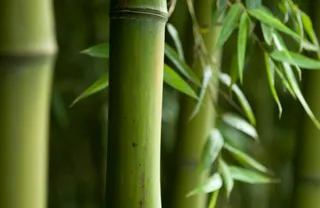
Bamboo - a mine of money | BLOG SHURUWAAAT AGRI
- Simran Arya

- Aug 9, 2021
- 4 min read
Updated: Aug 20, 2021
Bamboo is a fastest growing, durable, and versatile natural resource which can be substituted against the timber. Bamboo is widely cultivated commercially across India and it is also called “ poor man’s timber”. Bamboo shoots are considered a good source of nutrition and can be consumed as food.

#bamboocultivation #bamboocultivationmeaning #Byproductofbamboocultivation #currentstatusofbamboo #futureprospectofbamboo #bambooplant #bambootreemeaninginhindi #bamboopalm #bambooshoots #bamboofarming #abambooplant
| CONTEXT
•By Products of Bamboo
•How to grow Bamboo
1.climate requirement
2. soil requirement
3. Propagation
4. Fertilizer requirement
5. Irrigation
6 Harvesting
• Current status of Bamboo cultivation
• prospects of Bamboo cultivation
• Conclusion
| By-products of bamboo:
“ A man is born in a bamboo cradle and goes away in a bamboo coffin. Everything in between is possible with bamboo”. There are hundreds and thousands of commercial bamboo products in the market. Plus, innovations and applications are being added every day. Here are some which have good demand and price at the market:-
• Every bamboo forest hides the instrument for a whole orchestra- A wide variety of flutes are made up of bamboo as they present excellent sound properties. Many other instruments' raw materials including xylophone, drum stick, chimes, guitar, violins, clarinet, whistle come from bamboo. • Currently the Chemical processing and mechanical processing are the two processes currently make textiles from Bamboo. As it is a renewable resource that An acre of bamboo yields 50 times as much fiber as cotton per acre. It is also used to make bamboo fiber clothes. • Bamboo is effectively used to produce paper. It is strong and has wide applications, they are paper cups, cardboard, bond paper, toilet paper, typing paper, offset paper, etc.

• Bamboo bio energies like bamboo chips, bamboo charcoal, Bamboo briquettes, bamboo pellets, biofuel, biochar, etc. are some other by-products of bamboo. •Bamboo charcoal air purifying bags are effective in deodorizing ( absorb odors from air). Its stem is used to make a basket. • Bamboo internodes of Dendrocalamus or Gradua angustifolia are very well suited for making bamboo beehive. • Bamboo leaves aid digestion, reduce inflammation, and are also used in medicines for treating hypertension, cardiovascular disease, and certain forms of cancer. • Bamboo shoot is edible and contains a powerful source of fiber. Bamboo salt and bamboo vinegar are used to control diabetes and cholesterol.#ilovebamboocultivation #bambooproducts #bambooproductsonline #bambooproducts

| Climate for Bamboo cultivation-
Bamboo grows well in hot to warm temperate climatic conditions in Arunachal Pradesh, Assam, Manipur, Meghalaya, Mizoram, Nagaland, Sikkim, Tripura, West Bengal, etc. In summer, it doesn’t require a temperature below 15°C.

| Soil requirement for the Bamboo cultivation-
Bamboo can be cultivated on a wide variety of soil and requires well-drained sandy soil to clay soil with a pH range of 4.5 to 6.0.
| How to Propagate-
The Bamboo is propagated through the culms cutting or rhizomes. In rhizome planting method, culms of 1 year
Along with roots are cut into 1-meter size and planted in the rainy season. The pits size of 60*60 must be dug.

| Fertilizer used in Bamboo cultivation -
Fertilizers with components of Potassium and Nitrogen are vital. We must also apply green manure, organic compost, wood ash, and chemical fertigation(fertilizer + irrigation).
| Irrigation in Bamboo cultivation-
You must drain out the soil especially during heavy rainfall or flooding because Bamboo trees are sensitive to waterlogging. You can also adopt a drip irrigation system for better cultivation of water.

| Harvesting of Bamboo-
Harvesting can be done from the sixth year in commercial farming. The unit cost for 1 acre of plantation is around Rs.9400.
Hence, bamboo has a low gestation period, faster growth, and gives a recurring economic return, for generations.
| Current status of Bamboo in the Indian market-
In India, about 25% of bamboo species are distributed in almost all the states. India’s productivity of bamboo is one-fourth to one-fifth.
Recently, a report released by Technology Information, Forecasting and Assessment Council ( TIFAC) titled,
“ Techno-economic feasibility on Indian Bamboo as Wood Substitute”
The current market demand and supply focus on action for the active promotion of bamboo cultivation. It has socio-economic and ecological value and its management can provide benefits at local, national, and global levels through economic, livelihood, and environmental security for rural people. The Bamboo based cottage industry enhances cash income for people.
-The State- level initiative is taken for skill development in the Bamboo sector:
•Assam bamboo and came policy
•Nagaland bamboo policy
•Manipur bamboo policy
•Maharashtra bamboo development board
•Tripura bamboo policy

| Future Aspects of Bamboo in the Indian market-
India is moving towards increasing awareness and export of bamboo products, supporting local artisans under National Bamboo Mission launched by PM Narendra Modi.
Domestic and global market products like agarbatti, furniture, biofuel, textiles, etc. are produced by bamboo under Atmanirbhar Bharat Abhiyan to initiate Bamboo based industry. It can also be a huge employment opportunity for rural people. With the support of the government, we can unlock the actual potential of the bamboo sector.
The bamboo sector can be the main pillar of the medicinal, building, paper, and ecological sectors.

| Conclusion-
Bamboo has multiple utilities fodder timber, pulp, construction work, charcoal, cottage industries, etc. in the Indian market and these products are largely in high-income countries. There has been increasing awareness about its sustainable products and consumption. ‘ Waste utilization’ has been the bane of bamboo used in India. Bamboo cultivation, if done in a organized way can boost the local economy and increase farm income, to a large extent.











Comments